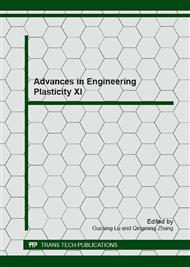p.306
p.310
p.314
p.318
p.322
p.326
p.330
p.334
p.338
Study on Heading and Thread-Rolling Processes of Magnesium Alloy Screws
Abstract:
This study is to investigate the effects of the process parameters on the heading load and metal flow pattern during heading and thread-rolling processes of LZ91 magnesium alloy screws. A heading process composed of two stages is proposed. The material flow pattern of the billet inside the die is analyzed using the finite element analyses. The effects of the upper die velocity, temperatures and friction factors on the heading loads and product quality are discussed. On the other hand, in the thread-rolling process, the effects of the friction factor on the effective stress, effective strain, and tooth height are investigated. Finally, heading and thread-rolling experiments are conducted using a self-designed die set and a lubricant of MoS2. The experimental values are compared with the simulation results to verify the validity of the finite element models and the proposed heading procedures.
Info:
Periodical:
Pages:
322-325
Citation:
Online since:
January 2013
Authors:
Price:
Сopyright:
© 2013 Trans Tech Publications Ltd. All Rights Reserved
Share:
Citation:


